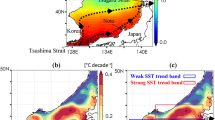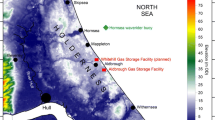Abstract
FOR some time it has been apparent that the direction of bed-load transport in tidal seas is largely determined by an asymmetry in the current ellipse, such that the peak velocity reached in one direction is greater than that reached in the reverse direction. The degree of tidal asymmetry need not be very great to assure sand transport in the direction of strongest flow, as the ability of a current to move sand increases steeply with increasing velocity. The asymmetry of near-surface tidal currents1 has been used together with the asymmetry shown in the cross-sectional profile of sand waves to delineate bed-load transport paths around southern Britain2 and the Irish Sea3, in spite of the lack of data on the movement of the near-bottom water. This shortcoming has now been removed by means of measurements of currents at between 4 and 5 m off the bottom made by the Lowestoft Fisheries Laboratory (Ramster, personal communication) in the north-eastern Irish Sea (Fig. 1). It can now be clearly demonstrated that there is a regional congruence between the directions of sand-wave asymmetry and near-bottom (as well as near-surface) tidal current asymmetry in this area. The sand waves are situated within a zone analogous to those occurring elsewhere4, although in this case the zone is somewhat discontinuous because of paucity of sand, which in some parts allows only small trains and isolated crests to be present. The sand may be derived from as far afield as North Channel or the bed-load parting in St George's Channel; it eventually travels into the Solway Firth and Liverpool Bay, together with some deposition west of a patch of muddy sediment between the sand wave zone and the Lancashire and Westmorland coasts (Fig. 1 inset; for further details of the sediments, see ref. 5).
Similar content being viewed by others

References
Atlas der Gezeitenströme für die Nordsee, den Kanal, und die Britischen Gewässer (Deutsch. Hydrograph. Inst., 1963).
Stride, A. H., Quart. J. Geol. Soc. Lond., 119, 175 (1963).
Belderson, R. H., Mar. Geol., 2, 147 (1964).
Belderson, R. H., and Stride, A. H., Mar. Geol., 4, 237 (1966).
McQuillin, R., Tully, M. C., Hull, J. H., and Rhys, G. H., Cruise Report: North East Irish Sea Investigations, Aug.–Sept. 1967, (Inst. Geol. Sci., 1968).
Sager, G., Beitr. Meereskunde, 1, 19 (1961).
Author information
Authors and Affiliations
Rights and permissions
About this article
Cite this article
BELDERSON, R., STRIDE, A. Tidal Currents and Sand Wave Profiles in the North-eastern Irish Sea. Nature 222, 74–75 (1969). https://doi.org/10.1038/222074a0
Received:
Issue Date:
DOI: https://doi.org/10.1038/222074a0
- Springer Nature Limited




